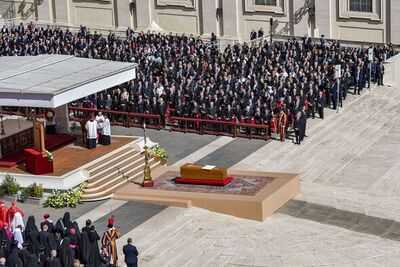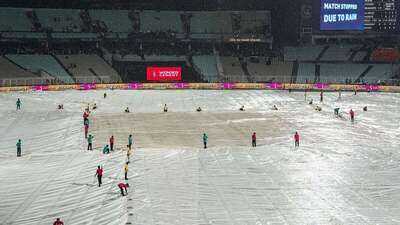The Central Highlands of Vietnam blends nature and culture, with Da Lat’s pine forests, Dak Lak’s waterfalls, and the Ede people’s wooden longhouses reflecting its rich heritage.
The landscapes are just as diverse, with green tea hills, crater lakes, and mountains waiting to be explored. The people of the Central Highlands are connected to their traditions, from gong performances to the communal sharing of can wine.
Their cuisine, shaped by the highland terrain, brings flavors such as the bamboo-cooked rice or grilled meats, and the aroma of Vietnam’s finest coffee.
Whether you’re trekking through national parks, visiting ethnic villages, or simply breathing in the highland air, the Central Highlands is not just a place to visit but an experience to immerse in.
Climate
The Central Highlands has two seasons: the rainy season (May to October) and the dry season (November to April). It’s important to note that due to the higher altitudes of the Central Highlands, temperatures are generally lower than in other regions at comparable latitudes.
The rainy season brings warm temperatures and heavy rain, making the landscapes green and lush.
The dry season is cooler, with temperatures between 12 and 15 degrees Celsius from November to January. From February to April, it gets hotter, reaching over 30 degrees.
While each season has its charm, the dry months are the best time for outdoor exploration. Special seasonal highlights include the blooming of coffee flowers from late February to April in Dak Lak and Dak Nong, wild sunflowers cover Dak Lak in November, and cloud-hunting opportunities from April to June in Bao Loc.
How to get there
The Central Highlands is accessible by air, bus, and private transport, with multiple entry points depending on your destination.
By air: The region has several airports:
– Lien Khuong Airport (Lad Lam Dong): Receives Fights From City and Hanoi.
– Buon Ma Thuot Airport (Dak Lak): Offers domestic flights from Hanoi, Ho Chi Minh City, and Da Nang.
– Pleiku Airport (Gia Lai): Connects to major cities like Hanoi and Ho Chi Minh City.
By bus: Long-distance sleeper buses connect the Central Highlands to major cities like Ho Chi Minh City, Da Nang, and Nha Trang. Travel times vary from 6 to 12 hours, depending on the destination.
By car or motorbike: For those seeking adventure, National Highway 14 is the main route from Ho Chi Minh City to Buon Ma Thuot, Gia Lai, and Kon Tum, while Highway 20 leads to Da Lat and Bao Loc. The roads offer routes through tea plantations, waterfalls, and ethnic villages.
Once in the Central Highlands, travelers can rent motorbikes, hire private cars, or take local buses to explore different destinations.
Will give years
Da Lat City, often called the “City of Eternal Spring,” is known for its cool climate, colonial architecture, and lush landscapes. In the past, this city was once a summer retreat for the French. The best time to visit is from November to May, when the weather is dry.
Visitors can explore French-era villas on Le Lai Street, take a night tour at Da Lat Railway Station, or visit the Hang Nga Guesthouse (Crazy House), an architectural wonder.
Nature lovers will enjoy Langbiang Mountain, Cau Dat Tea Plantation, and Linh Phuoc Pagoda. Langbiang Mountain is home to some of the oldest ethnic communities in the Central Highlands. Visitors can explore traditional villages, join gong dances, and enjoy a family meal with the Lach people, one of Da Lat’s first inhabitants, accompanied by ruou can (fermented rice wine).
For unique experiences, travelers can go cloud hunting between April and June, enjoy an afternoon by Xuan Huong Lake or try canyoning at Datanla Waterfall.
At night, the Da Lat Night Market is a must-visit for street food lovers. Must-try dishes include banh can (mini rice pancakes with eggs) and banh mi xiu mai (pork meatball baguette). The city is also famous for avocados, strawberries and artichoke tea.
Bao Loc
Bao Loc is a mountain city, often overshadowed by Da Lat but offering a peaceful alternative with tea plantations, waterfalls, and spiritual retreats. Known for its cool climate, Bao Loc is best visited from December to April. From April to June, the town is also a prime location for cloud hunting.
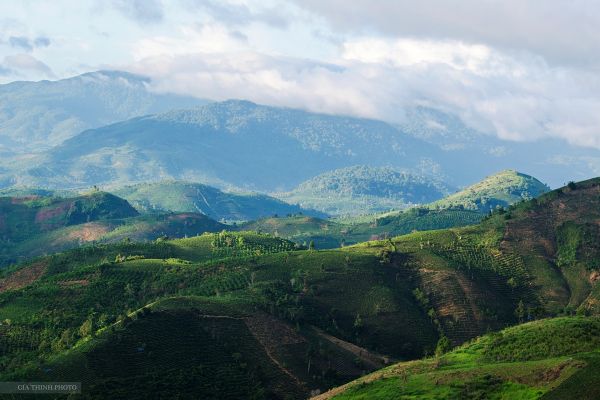
Nature enthusiasts can explore Dambri Waterfall, the tallest in the region, where visitors can ride a 1,650-meter alpine roller coaster – the longest in Southeast Asia. Linh Quy Phap An Pagoda, located on Dai Binh Mountain, is famous for its views, where mist and clouds often surround the temple.
Meanwhile, Tam Chau Tea Plantation, known as the “tea capital” of the Central Highlands, offers visitors a chance to explore green tea fields and learn about Vietnamese tea cultivation and production.
Adventure seekers can hike through Madagui Forest, camp in the eco-tourism area, or experience cave trekking and zip lining. The treehouses near Dambri Waterfall provide an overnight stay surrounded by nature.
Local specialties include pho settle (dried noodles), good bo (beef noodles), and Banh mi nong muoi ot (grilled baguette with chili salt). For dessert, grilled banana with sticky rice is a must-try.
Dak Lak
Dak Lak Province, the heart of the Central Highlands, is known as Vietnam’s coffee capital. The best time to visit is from November to April, when the weather is dry and ideal for exploring.
Visitors can experience Buon Don, famous for its elephant-taming culture, and tour the Elephant King’s Tomb and ancient stilt houses. Nature lovers can visit Lak Lake, Vietnam’s second-largest freshwater lake, where they can ride dugout canoes or visit M’nong villages. The region’s waterfalls, including Dray Nur and Dray Sap, showcase the beauty of the Serepok River.
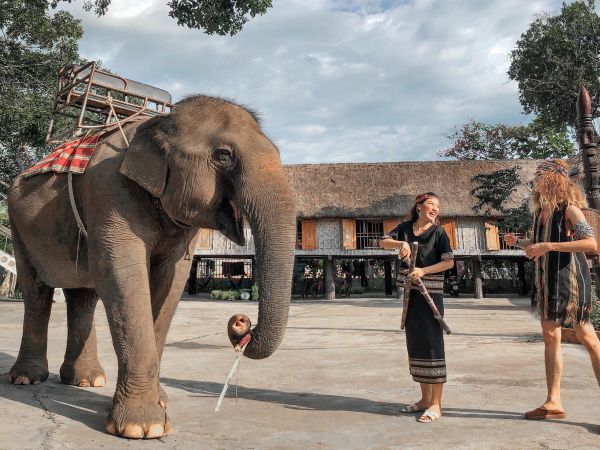
Those interested in culture can experience gong performances, explore longhouses, or enjoy a meal of lam (bamboo-cooked rice) and grilled chicken with local communities.
Must-try dishes include good do (red noodle soup), ball uot thit nuong (steamed rice rolls with grilled pork), and Bo Nhung Me (beef dipped in tamarind sauce). A visit is not complete without trying Dak Lak’s robusta coffee, best enjoyed at a local café or the Coffee Village in Buon Ma Thuot.
Not
Dak Nong Province is a land of volcanic landscapes and indigenous culture. It is home to UNESCO-listed Dak Nong Global Geopark. The best time to visit is from November to April.
Discovered in 2017, Dak Nong’s volcanic cave system spans nearly 10,000 meters across 50 caves, making it one of Southeast Asia’s longest. Dating back 140 million years, it preserves prehistoric relics, offering insights into human life 6,000 – 7,000 years ago. Now part of the UNESCO Dak Nong Global Geopark, it remains a key archaeological and geological site.
Visitors can explore Ta Dung National Park, often called the “Ha Long Bay of the Central Highlands”, where over 40 islands dot a vast lake. Nearby, the Nam Kar volcanic range and Lieng Nung Waterfall offer rugged trekking routes through untouched forests.
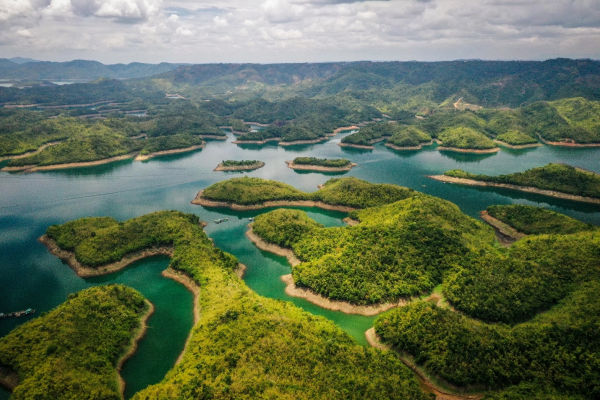
Ta Dung Lake is often referred to as the Central Highlands’ equivalent of Ha Long Bay, featuring lush green landscapes and pristine turquoise waters. Photo courtesy of Quy Coc Tu
In Yang Tao Commune, artisans keep the centuries-old M’nong pottery tradition alive, while Buor Village stands as the oldest Ede settlement in the region. For those seeking serenity, Truc Lam Dao Nguyen Zen Monastery provides a retreat amid the highland mist.
Dak Nong’s cuisine features bamboo-tube rice, grilled meat, and rattan bud soup, a dish made with wild vegetables and fish. The region is also known for high-quality coffee, Dak N’rung pepper, macadamia nuts, and Dak Mil avocados.
Many the
Mang Den Town is a retreat known for its cool climate, pine forests, lakes, and waterfalls.
The best time to visit is from October to December, when the apricot blossoms begin to bloom. Visitors in February can enjoy mimosa and bauhinia flowers, while March and April bring purple phoenix blossoms.
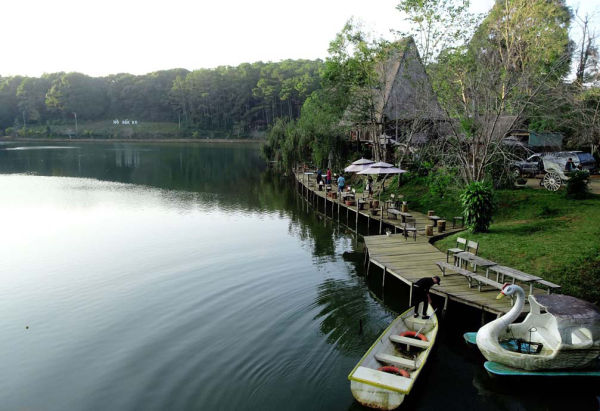
Tucked in the misty hills of Mang Den, Pa Sy Waterfall tumbles from 1,500 meters above sea level, fed by three converging streams. Nearby, Dak Ke Lake offers an escape with boating, fishing, and carriage rides. At local high-tech farms like E Ban Farm and Orfarm, visitors can pick fruits straight from the trees.
For a cultural experience, the Garden of Wooden Statues showcases 100 hand-carved sculptures reflecting highland traditions. Khanh Lam Pagoda, perched at 1,200 meters, blends Buddhist design with local architectural influences. Meanwhile, Mang Den Walking Street, or Sunset Boulevard, invites travelers to unwind among colorful buildings and cafes.
Mang Den’s cuisine includes Xuyen Tieu hot pot, a two-broth dish with wild pepper and bone broth, dried bamboo shoot chicken salad, and Banh Canh Ca Loc (snakehead fish noodle soup).
Gia Lai
Gia Lai, Vietnam’s second-largest province, is a region of volcanic landscapes. The best time to visit is November to April, during the dry season.
Bien Ho Lake (T’Nung Lake), a volcanic crater 7 kilometers from Pleiku, is surrounded by towering pines, creating a retreat. Nearby, the Bien Ho Tea Hills, established in 1919, stretch across 1,000 hectares.
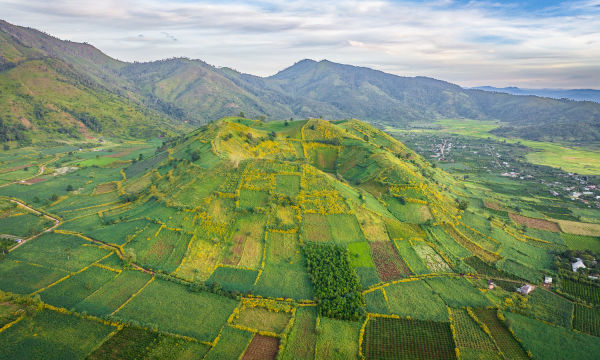
For breathtaking views, Chu Dang Ya Volcano, 30 kilometers from Pleiku, is best visited in October and November, when wild sunflowers blanket its slopes. Deep in Kon Chu Rang Nature Reserve, K50 Waterfall plunges 50 meters, making it one of the most spectacular falls in the Central Highlands.
Gia Lai’s century-old pine forests provide walking trails, while its historic pagodas offer cultural insight. Minh Thanh Pagoda, blending Vietnamese and Japanese architecture, and Buu Minh Pagoda, the province’s oldest, serve as spiritual spots.
Local specialties include two-bowl pho, a local take on Vietnam’s noodle soup, comes with separate bowls of dry noodles and savory broth. Other must-try dishes include half-dried beef with local spices and stinky crab noodle soup made with fermented crab paste.
Story by Phuc Trinh
Gia Lai Travel Guide: Body

